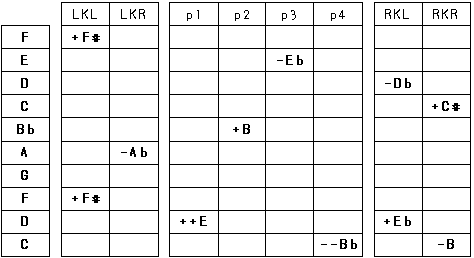"Concert F" 10 String Diatonic Tuning

(This page is also available as plain text)
Here's the tuning I'm currently using for classical, new age and progressive (non-blues) rock music. It's a ten string tuning based on the diatonic scale in the key of F.
I continue to use the E9th for country, swing, blues and most rock music. For jazz the E9th is better for chords, but this F Diatonic is really nice for soloing. The F diatonic also works well for horn section parts in R&B - written parts are easier to read and to easier to find than they are on E9th.
Theory of Operation
The table below shows how pedal and knee lever combinations produce the key signatures of seven diatonic major scales with the bar positioned at the 7th fret (the "key of C" fret). These scales use strings 1 through 8 and have a range of one octave.
7th fret key pedal/knee scale signature combination C --- --- G 1 sharp Pedal 2 D 2 sharps Pedal 2 + Left Knee Left A 3 sharps Pedal 2 + Left Knee Left + Right Knee Right F 1 flat Pedal 3 Bb 2 flats Pedal 3 + Left Knee Right Eb 3 flats Pedal 3 + Left Knee Right + Right Knee Left
Using this tuning, I'm never more than one fret away from a full diatonic scale in any key signature at any fret. Pedals 1 and 4 are used in conjunction with 2 and 3, respectively, to add to the variety of foundation notes available from the low 2 strings.
As for temperment, I am tuning the open strings "straight up" to A440 equal temperment. I tune the changes for the flat keys about 5 cents sharp and the changes for the sharp keys about 5 cents flat. This directly counteracts the cabinet drop effect. The tuning tends to sound a bit "sweeter" than equal temperment as you stack the changes to get the more remote positions (i.e. 3 sharps or 3 flats).
-Bobby Lee, June 28 1996
| |